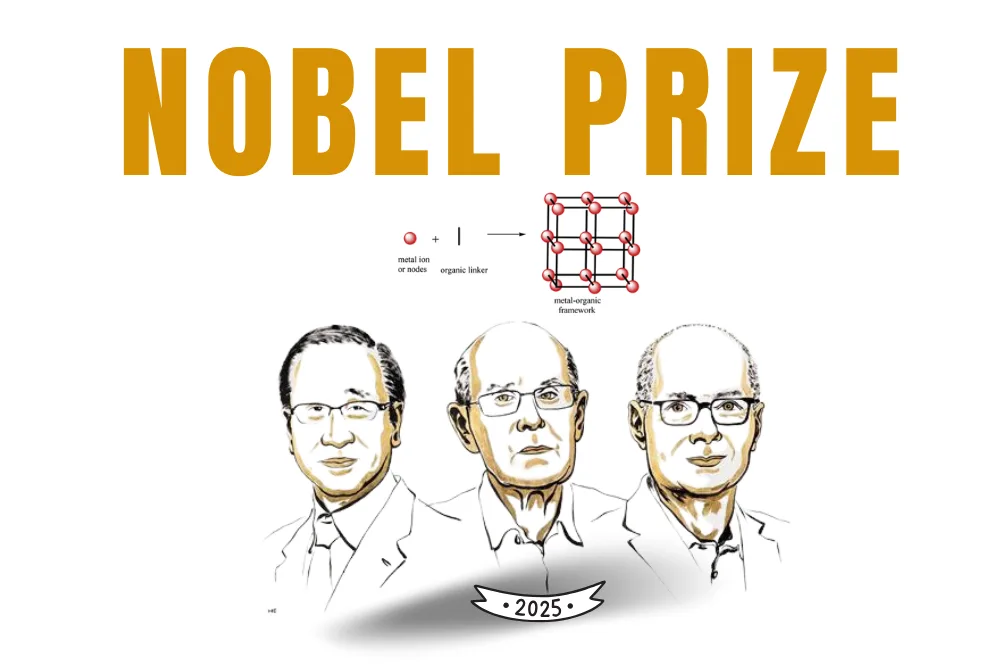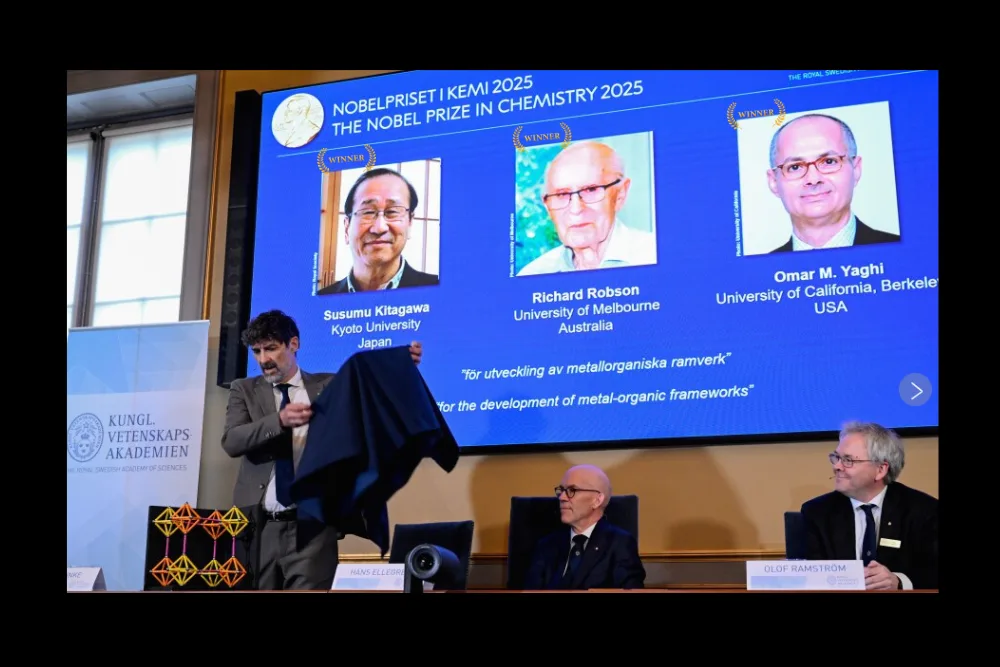Now Reading: The 2025 Nobel Prize in Chemistry
-
01
The 2025 Nobel Prize in Chemistry
The 2025 Nobel Prize in Chemistry

The 2025 Nobel Prize in Chemistry was awarded to Susumu Kitagawa, Richard Robson, and Omar Yaghi for their groundbreaking development of metal organic frameworks (MOFs). These are a new class of materials known for their extraordinary porosity and molecular precision. Their pioneering work has opened new frontiers in chemistry, energy, and medicine, earning them a shared prize of 11 million Swedish kronor (about USD 1.2 million).
What Are Metal Organic Frameworks
Metal organic frameworks, or MOFs, are highly porous materials made from a combination of metal ions (nodes) and organic molecules (rods). These components assemble into a stable, lattice-like architecture that contains countless tiny holes.
Each framework’s internal surface area is immense. A few grams of MOFs can have the same surface area as an entire soccer field. This vast internal space allows scientists to capture, store, and release gases or molecules in a highly controlled way.
Because these holes can be tailored to fit specific molecules, MOFs can hold substances like carbon dioxide, methane, or water with remarkable efficiency. This precision is what sets them apart from conventional materials.
Who Are Susumu Kitagawa, Richard Robson, and Omar M. Yaghi?
Susumu Kitagawa – Born in 1951 in Kyoto, Japan. He earned his PhD in 1979 from Kyoto University, where he now serves as a professor.
Richard Robson – Born in 1937 in Glusburn, UK. He completed his PhD in 1962 at the University of Oxford and is currently a professor at the University of Melbourne, Australia.
Omar M. Yaghi – Born in 1965 in Amman, Jordan. He received his PhD in 1990 from the University of Illinois Urbana-Champaign and is a professor at the University of California, Berkeley, USA.

The Scientific Breakthrough
The foundation for MOFs was laid in the 1980s by Richard Robson, who first developed early forms of these molecular networks. Susumu Kitagawa and Omar Yaghi expanded upon this idea, creating stable frameworks that retained their shape even when empty. This is one of the key achievement that made practical applications possible.
As Kim Jelfs, a computational chemist at Imperial College London, noted, the ability to control pore size and stability in these structures is “quite rare in chemistry” and “really efficient for storing gases.”
The frameworks function somewhat like Tinker Toys, where the metal centers and organic linkers can be interchanged to create customized architectures. This flexibility has made MOFs one of the most versatile materials discovered in recent decades.
Know more: molecular architecture contains rooms for chemistry
Why the Discovery Matters
The implications of MOFs reach far beyond academic research. These structures have the potential to help tackle global environmental challenges and advance medical science.
-
Carbon Capture and Environmental Cleanup: MOFs can absorb greenhouse gases like carbon dioxide, potentially helping to combat climate change and industrial pollution.
-
Water Harvesting in Deserts: Some researchers are developing MOFs that can extract moisture from dry desert air to provide clean drinking water in arid regions.
-
Targeted Drug Delivery: In healthcare, MOFs are being studied for their ability to carry and release medicines slowly inside the body, offering new ways to deliver cancer drugs and other therapies.
-
Industrial and Agricultural Uses: MOFs are already being used in packaging to keep fruits fresh during long shipments by gradually releasing ripening-slowing chemicals.
Despite their promise, scientists acknowledge ongoing challenges, such as maintaining stability under real-world temperatures and pressures. Yet, the possibilities remain vast and transformative.
Final Note
The 2025 Nobel Prize in Chemistry celebrates not only the brilliance of Susumu Kitagawa, Richard Robson, and Omar Yaghi but also the boundless potential of metal organic frameworks. Their innovation represents a new era in molecular design. It reshape how we store gases, purify air, deliver drugs, and even collect water.
Their discovery continues to inspire chemists and engineers worldwide to find practical ways to apply this molecular architecture to address some of humanity’s greatest challenges.
FAQs
What are metal organic frameworks used for?
They are used to store gases, filter pollutants, deliver drugs, and even extract water from air.
Who won the 2025 Nobel Prize in Chemistry?
Susumu Kitagawa, Richard Robson, and Omar Yaghi received the award for inventing metal organic frameworks.
Why are MOFs important?
They offer unmatched molecular control and storage capacity, which could help solve environmental and medical challenges.
How do MOFs store gases?
Their porous structure contains countless holes that trap gas molecules efficiently, even in small quantities of material.
Are MOFs used in industry today?
Yes, they are already used in packaging to preserve fruit and are being explored for larger-scale environmental and medical applications.
Dony Garvasis is the founder of Search Ethics, a platform dedicated to transparency, authenticity, and ethical digital practices. With over six years of experience in SEO and digital marketing, I provide expert content on automobiles, Artificial intelligence, technology, gadgets, science, tips, tutorials and much more. My mission is simple: Ethical Search, Genuine Results! I will make sure people everywhere get trustworthy and helpful information.









